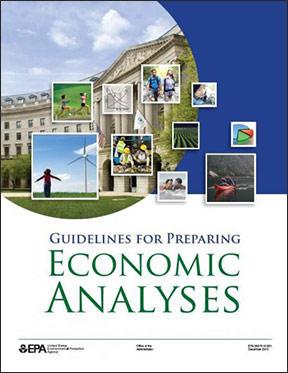Guidelines for Preparing Economic Analyses

In 2010, EPA published its final Guidelines for Preparing Economic Analyses.
- What are the Guidelines?
- Why are the Guidelines important?
- What topics are covered in the Guidelines?
- Who are the Guidelines for?
- How were the Guidelines produced?
- How will future updates to the Guidelines be incorporated?
- What's new in 2016?
- Download a copy of the Guidelines.
- Find further information on the Guidelines.
What are the Guidelines?
EPA's Guidelines for Preparing Economic Analyses establish a sound scientific framework for performing economic analyses of environmental regulations and policies. They incorporate recent advances in theoretical and applied work in the field of environmental economics. The Guidelines provide guidance on analyzing the benefits, costs, and economic impacts of regulations and policies, including assessing the distribution of costs and benefits among various segments of the population.
Why are the Guidelines important?
The Guidelines serve several important functions: (1) they assist policy makers in developing regulations that achieve the highest environmental quality and human health standards at the lowest costs; (2) provide analysts with information needed to prepare high quality economic analyses; (3) develop an overarching framework for economic analyses throughout the Agency and across EPA Program Offices; and (4) ensure that important subjects such as uncertainty, timing, and valuation of costs and benefits, are treated consistently in all economic analyses at EPA. EPA will use the Guidelines to evaluate the economic consequences of its regulations and policies to insure that they contribute to a safe environment and a healthy economy.
What topics are covered in the Guidelines?
The Guidelines address major analytical issues on key topics, including:
- Estimating the value of reduced health risks and improved environment quality
- Defining baseline conditions (i.e., contrasting the state of the economy and environment with and without a proposed regulatory policy).
- Discounting and comparing differences in the timing of benefits, costs, and impacts
- Assessing and describing who pays the costs and receives the benefits of regulations
- Locating available data sources for conducting economic analyses.
- Presenting the results of economic analysis, including non-monetary information
Who are the Guidelines for?
The main audiences for the Guidelines are those performing or using economic analysis, including policy makers, the Agency's Program and Regional Offices, and contractors providing economic reports to the EPA. However, the Guidelines may also be useful for those teaching courses on benefit cost analysis or environmental economics.
How were the Guidelines Produced?
Development of the Guidelines is led by the EPA's National Center for Environmental Economics (NCEE) in consultation with economists from across the Agency. All chapters undergo an external peer review prior to finalization, either through the EPA’s Science Advisory Board Environmental Economics Advisory Committee (SAB-EEAC) or through independent reviews by external experts.
-
Chapters 1-8, 11 and Appendix A and B – Reviewed by SAB-EEAC. The SAB-EEAC, comprising leading environmental economists from major universities and research institutions, assessed the chapters for accuracy in both economic theory and practice. In their final report to EPA Administrator Lisa Jackson, the SAB-EEAC offered specific recommendations for improvement, but noted that "...the Guidelines significantly elevate the quality and transparency of the information upon which environmental decisions are made." The chapters were revised in response to the comments of the SAB-EEAC.
-
Chapter 9 (Economic Impact Analysis) -- Review Pending. An earlier version of Chapter 9 (Economic Impact Analysis) was reviewed by the SAB-EEAC but several sections of the chapter, namely sections 9.2.3.2 Impacts on Production, 9.2.3.3 Impacts on Employment, and 9.2.3.4 Impacts on Profitability and Plant Closures, were since revised significantly and are still undergoing revision as we incorporate new literature and advice from the SAB’s Economy Wide Modeling subcommittee (their draft report is not yet available but is expected soon). Once completed, these sections will undergo a separate peer review prior to finalization.
-
Chapter 10 (Environmental Justice, Children’s Environmental Health and Other Distributional Considerations) – Reviewed by three external experts. Chapter 10 was released in May 2015 following peer-review by three independent, external experts.
NCEE will continue to update chapters of the Guidelines as warranted and as the science evolves. New chapters and updates to existing chapters will be peer-reviewed prior to finalization.
How will future updates to the Guidelines be incorporated?
EPA intends to revise and update these Guidelines periodically to capture new literature and the best available science. As new chapters are developed or existing chapters revised, they will be made available for download on this website once they pass external peer review. Each chapter will contain a date stamp indicating its "publication" date.
What's new in 2016?
Chapter 9: Economic Impacts – Notice of Pending Revisions
EPA is in the process of revising its guidance for assessing the employment impacts of environmental regulation. The current Section 9.2.3.3 “Impacts on employment” will be replaced. In the interim, EPA recommends that analysts refer to recent EPA Regulatory Impact Analyses (RIAs) for best available methods and approaches for conducting employment impact analyses. For more details and links to recent RIAs, please see the new cover page to Chapter 9.
Download a copy of the Guidelines.
The Guidelines are available for download as a single PDF here.(PDF, 2.3 MB, About PDF). Individual chapters (all PDF documents) are also available:
Find further information on the Guidelines.
Nathalie Simon (Guidelines Project Leader): 202-566-2347, simon.nathalie@epa.gov
Al McGartland (NCEE Director): 202-566-2244
